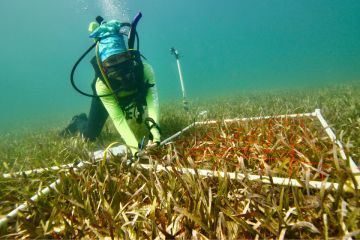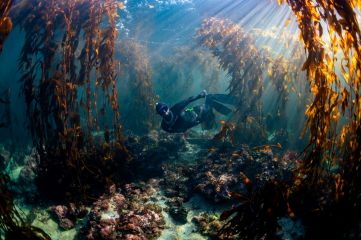Artificial reefs: junk or habitat?
- Valerie Shore

Are artificial reefs the most effective way to conserve troubled marine fish populations?
Over the last 27 years, eight ships and one airplane have been intentionally sunk off the BC coast for the enjoyment of recreational divers—and to enhance habitat for local marine life.
Yet artificial reefs remain controversial. Advocates say they provide new habitat opportunities for fish and eventually mimic natural reef settings. Critics dismiss them as dumped garbage, saying there are more effective ways to enhance critical fish habitat.
So which is it? Desiree Bulger, a master’s student in the University of Victoria’s School of Environmental Studies, set out to find some answers.
“As I learned more about artificial reefs around the world I discovered how variable their effectiveness is,” she says. “Review papers suggest that only 50 to 60 per cent of conservation-focused reefs are meeting their goals.”
For her study—the first of its kind to assess the conservation effectiveness of BC’s artificial reefs—Bulger targeted groundfish, especially rockfish, found on rocky reefs along the south coast.
“Rockfish are in the middle of the food chain and affect a lot of other species,” she explains. “They’re also a fish we want to eat and are very susceptible to being overfished. Several species are listed as threatened or of special concern.”
Underlying her research were three basic questions: How do BC’s artificial reefs compare to natural rocky reefs? Are they effective in supporting groundfish communities? And what features make a good artificial reef?
Using a remotely operated vehicle (ROV) supplied by UVic mechanical engineer Brad Buckham, along with multi-beam sonar technology, Bulger surveyed nine artificial reefs and nine natural reefs at sites from Sidney to Campbell River to the mainland. Depths ranged from 10 to 45 metres.
She and her field crew of five—four undergraduates plus one engineering graduate student—ran the ROV along transects at each site, shooting video and documenting depth, current, slope, roughness of surfaces, and nearby habitat quality.
Mapping software was used to select natural reef sites, which ranged from underwater ridges to boulder fields and rocky walls. They were situated as close as possible to the artificial reefs.
The oldest artificial reef surveyed was the steamship Capilano, which foundered near Powell River in 1915. The newest was the navy destroyer Annapolis, which was intentionally sunk in Howe Sound in 2015.
Bulger later slogged her way through hours of video counting groundfish. “I got very good at identifying fish-shaped blobs in poor visibility,” she laughs.
In all, she observed 14 groundfish species, eight of them rockfish. Most striking was the difference between abundance and biodiversity at reef sites.
Artificial reefs had very high numbers of rockfish or not many at all. Natural reefs consistently had a medium number of rockfish and greater diversity—more species.
—Desiree Bulger, master's student in UVic's School of Environmental Studies
Bulger is now using the sonar data to create high-definition 3D maps of each site. “I’m looking at more fine-scale physical characteristics that may be driving fish patterns. This could have implications for future artificial reef design.”
More studies need to be done to better understand how artificial reefs impact an ecosystem before moving forward, advises Bulger.
“This study suggests that human-made habitat may be useful in the conservation of some threatened species. But to get diverse ecosystems, preserving older, more heterogenous natural reefs may be the best option.”
EdgeWise: additional reading

- BC’s rocky reefs are biological hotspots, providing food-rich upwellings, critical living space and refuge for a wide variety of marine life. Threats include overfishing, anchor damage and climate change.
- There are 38 species of spiky, spiny, striped and speckled rockfish along the BC coast. They’re slow to grow and reproduce and some can live more than 100 years. They live in the same tiny habitat all their lives, making them extra sensitive to fishing pressure.
- What can you do to help? Rockfish are often caught as accidental bycatch but rarely survive when released on the surface due to decompression damage. Fishermen are urged use a descending device to lower the fish back to depth of capture.
- Bulger’s work was supported by the Marine Technology Society, Fisheries and Oceans Canada and UVic.
- Desiree Bulger is part of a research team led by ecologist John Volpe in UVic’s School of Environmental Studies. Volpe's lab explores linkages between ecological and social sustainability, particularly in marine-based food production systems.
- UVic is a national and international leader in ocean health research, with strengths in ocean observing, climate modelling, marine ecology, and ocean chemistry and physics. Working with coastal communities, governments and other stakeholders, our researchers explore how climate-forced changes can be managed to support ocean sustainability.
Photos
In this story
Keywords: oceans, wildlife, fish, mapping, research, graduate research, environmental studies, conservation, ecology
People: Desiree Bulger, John Volpe
Publication: knowlEDGE






